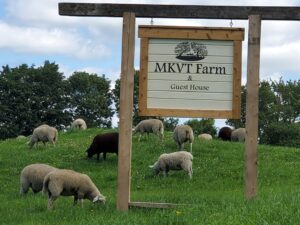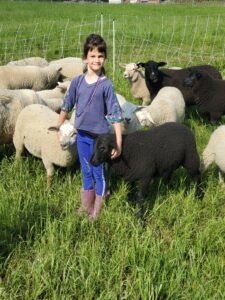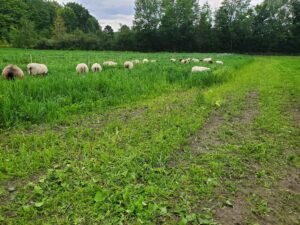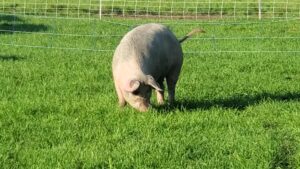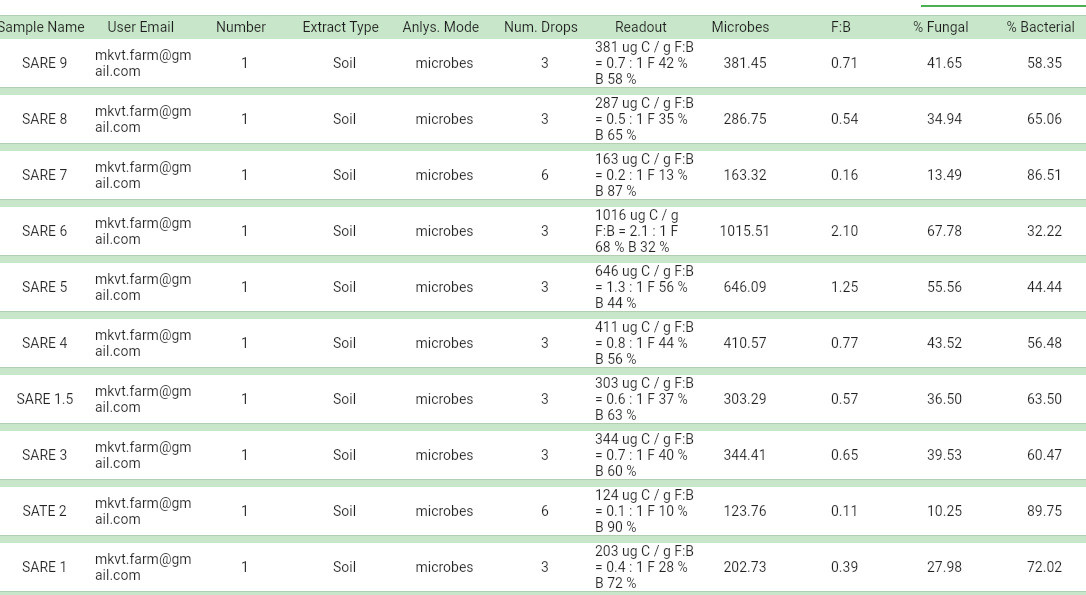Final report for FNE22-027
Project Information
We were successful in documenting the increased CLA (Conjugated Linoleic Acid) produced in our animals when nourished by forages supplemented by Organic Fish Hydrolysate from Neptune's Harvest. Neptune's Harvest has an advantage in this market since they use only the inedible portion of edible fish (not junk fish), they use a cold fermentation to retain maximum value as a soil amendment, and they are right here in New England.
We tested our soils with a MicroBiometer for increases in microbial activity and found microbial populations growing and fungal to microbial ratios improving in soils treated with Fish Hydrolysate. We found that compost in addition to the fish amendment accelerated the growth in microbial populations and the fungal to microbial ratios which makes the soil more fertile, more able to withstand drought or to drain water during wet times, and increases soils ability to sequester carbon.
The lambs, pigs and chickens we raised on the fish supplemented grasses all had elevated CLA measures especially compared to meat found in the supermarket, even that labeled "grass fed" based on our test results from Eurofins. Our lamb was 300% higher, chicken 50% higher and the pork was over 1000% higher than "premium" supermarket meats (The company validated this test result as accurate for that sample but we should and will submit more to improve reliability) .
We have provided this information to over 200 people subscribing to our newsletter, 500 more on Face Book and Instagram. We are prepared to do interviews now to share our findings with farmers and their customers.
This project sought to enhance soil health and microbiome with biostimulants from organic fish hydrolysates and animal compost.
This project sought to quantify nutritional enhancements including increased levels of Conjugated Linoleic Acid of lamb, pork and chicken pasture raised on forages supplemented with fish hydrolysate and compost versus conventionally raised lamb, pork and chicken.
This project sought to identify the economic advantages of organic fish hydrolysate amendments in Pasture raising lamb, pork and chicken.
This project sought identify the advantages in forage nutritional quality and yield economics of organic fish hydrolysates versus commercial fertilizers.
We intend to verify the benefits of grazing and additionally, illustrate and quantify the benefits to animals, soils, and grasses, of foliar feeding grazing pasture with fish hydrolysate and compost supplementation. There is anecdotal evidence and some research of the benefits of pasture raised animals. Most of the research has been conducted on dairy cattle with an emphasis on fatty acids in milk where there is a great difference between conventional and organically grazed animals. There is a large increase in mono- and poly-unsaturated fatty acids (the healthier fats) and a decrease in the saturated fatty acids when animals are grazed.
The additional benefits of improved microbiome of the soil will be chronicled with soil analysis after amendments, forages will be sampled both as grazing and as harvested forages for winter feeding. We will analyze the nutritional value of the meat from pigs, lambs, and chickens, pasture raised on forage supplemented with organic fish hydrolysate and compare to the meat from animals with the same genetics raised in 2021 on conventionally fertilized pastures.
We will specifically be applying Neptune’s Harvest Fish and Seaweed Fertilizer at 28-day intervals (weather permitting) to promote the growth of beneficial bacteria in the soil, making it less compact, better able to drain and providing an improved environment for forages. The Neptune amendments are cold processed, so they retain vitamins, amino acids, enzymes, and natural growth hormones (biostimulants) to organically rebuild soil fertility and increase yields from a renewable aquatic resource located here in New England. Biostimulants are not fertilizers as they do not provide nutrients directly to plants, but they can facilitate the acquisition of nutrients by supporting metabolic processes in soil and plants. Biostimulants are often of animal origin. Animal sources of biostimulants are usually hydrolysates of food by-products such as casein, fish waste or animal tissue.
We expect our findings to support the organic and natural rebuilding of soils that have been damaged through abuse or neglect. The quantification of this information will be an important step in identifying the economic advantages (or disadvantages) of foliar feeding of soils and forages to enhance crop and production of lamb, pork and poultry. This data will be significant to the understanding of how small and medium sized farms can be diversified and profitable, provide healthy nutritionally significant products to customers, and embrace sustainability utilizing locally sourced, renewable, environmentally beneficial farm inputs.
Ameliorated productivity with the reduction or elimination of chemical inputs, complimented by the expected improvement of the nutritional gains in forages and meat products from animals raised on upgraded pastures will help differentiate new products for Northeast farmers. Increases in yield and value while symbiotically improving soil, water and natural resources will enrich opportunities for farmers, home gardeners and the communities where their products are available.
Lamb meat contains the highest levels of Conjugated Linoleic Acid (CLA) of any ruminant source. It has been stated in several scholarly reports that certain fatty acids have positive effects on human health (see following paragraph). We know diet and genetics can alter the composition of ruminant meat. We hope to show an increase in CLA levels in our lamb products and our pork and poultry with implementation of our management of soil, vegetation, animals and environment.
"In the last few decades there has been increased consumer interest in the fatty acid (FA) composition of ruminant meat due to its content of saturated FAs, which have been implicated in diseases associated with modern life. However, recent studies have questioned the recommendations to reduce intake of fat, saturated FAs, and cholesterol as a means of reducing the risk of cardiovascular disease. Interestingly, ruminant meat has some bioactive lipids such as C18:1t11 and C18:2 c9, t11 which have been reported to have positive effects on human health. In order to improve muscle fat composition from a human health standpoint, oilseeds, plant oils and marine oils can be used in ruminant diets. On the other hand, molecular mechanisms play an important role in the alteration of the FA composition of muscle fat. Genetics offer a wide range of possibilities for improvement of muscle fat composition by identifying different loci underlying the expression of quantitative traits. While significant progress has been made in characterizing the influence of diet on the FA composition of ruminant meat, the use of genetic tools can favor genotypes that could maximize their genetic potential through the diet." © 2016 Society of Chemical Industry
https://doi.org/10.1002/jsfa.8168
Mark has been involved in agriculture for 50 years since childhood. Karen is new to agriculture, starting in 2015 but I have studied horticulture and have always loved animals. We farm full time and run a Bed and Breakfast on 75 acres. We market Pasture Raised Pork, Lamb, Chicken and Beef direct to consumers. Last year we marketed 30 pigs, 50 lambs, 900 chickens and 12 beef.
Cooperators
- - Technical Advisor
Research
Methods as proposed
Our study is multidimensional with analysis of soil, vegetation, and animals.
Soil samples will be taken prior to fish hydrolysate supplementation and after each subsequent application and sent to the University of Vermont soil lab. We will look specifically at soil acidity and nutrient analysis (primarily N, P, & K) We will attempt to identify microbial populations at Eurofins and statistically quantify the changes through the course of the year.
Forage samples will be conducted as grazing samples prior to groups of animals being introduced to each paddock. Yield estimates will be determined using industry standard calculations. Forages harvested for fall and winter feeding from 4 separate fields (not used for grazing), each split in half with half receiving Fish Hydrolysate supplementation with compost and half receiving regular commercial fertilization will be analyzed and differences in forage nutritional quality reported. All costs for supplementation and application will be included in the report to determine the economic viability and differences of the treatment. Forage samples will be sent to Lancaster DHIA Forage lab, Manheim PA, an affiliate lab of Rock River Laboratories.
Lamb birth weights will be recorded with birth dates and each animal tagged with a unique USDA Scrapie tag for identification. Slaughter dates and individual animal weights will be recorded to ascertain average daily gain. We will obtain meat samples from each of the slaughtered animals for nutritional analysis. We will specifically be looking for the levels of Conjugated Linoleic Acid (CLA) in the lambs and will obtain as many additional nutritional profile results as testing will allow. These will be compared to 2021 lamb samples, offspring from the same ram and ewe breeding flock as 2022. 29 ewes are bred with lambs due to be born March 1 to April 20.
Piglet birth weights and dates will be recorded, and each piglet tagged with a unique USDA RFID tag for identification. Slaughter dates and individual animal weights will be recorded to ascertain average daily gain and compared to 2021 slaughter pigs. We will obtain meat samples from each of the slaughtered animals for nutritional analysis. We will specifically be looking for the levels of Conjugated Linoleic Acid (CLA). These results will be compared to the 2021 pork samples from pigs sired by the same boar and out of the same sows as the 2022 herd. 3 sows will be bred with piglets due from March 10 to April 1.
Chickens are purchased from Moyer’s hatchery in Quakertown PA. Shipments of 150 straight run chicks from hatches on May 16, May 30, June 13, June 27, July 11, July 25, August 8, and August 25 will be split into 2 groups of 75 chicks per portable chicken house. The July 25 batch will be grown for 8 weeks, all other batches will be harvested at 7 weeks. Completion rate and harvest weight will be recorded for each animal within each group, rate of gain will be calculated and compared to 2021 birds. We will also take breast meat samples to be evaluated for nutritional content and compared to 2021 samples.
The Best Laid Plans
As I read through these well thought out plans I shudder to think how much could have possible changed to upset the whole thing. When the proposal was written we were not aware Bird Flu would rear its ugly head (fortunately we didn't have any but we had to prepare)and create a massive shortage of chicks, chickens and eggs in this country. The cost of building materials exploded to ridiculous levels, fuel price doubled, feed and fertilizer also doubled and tripled in some cases. The weather was too cold and wet then too hot and dry. We had one shipment of chicks that had 100 out of 150 dead, another 50 out of 150 dead and that upended our slaughter schedule so instead of 6 dates we now had 8. We were lucky to have appointments to have our animals processed as the workforce dwindled and butchers became backlogged. Our slaughter house was shut down for 3 weeks this fall and that turned into a nightmare for the butcher, us and our customers as the delays were compounded.
The good news is that even though everything didn't go according to plan and we didn't get everything done exactly as we hoped, our results confirmed our hopes and expectations. We now have some data that supports our theory and we can build on that. We will continue to do what we have started and we will continue to monitor and test so we can be an example to farms who wish to make an effort to change for the better and farm more sustainably. Our customers will also share the benefit of eating good food, sustainably raised.
This bar graph shows the differences between 2022 MKVT Lamb, Pork and Chicken and premium supermarket products of the same cut.
Our 2022 Lamb at 370mgCLA/100gFat was almost 10% higher than our 2021 sample that was 340mg/100g. Our 2022 Lamb has over 3 times the CLA of New Zealand grass fed lamb at 110mg/100g.
Our pork results are astounding (the result have been verified by Eurofins as accurate for the sample submitted but since the results are not within the expected range we will send more pork samples. Our 2022 pork had 490 mgCLA/100gFat versus the 30mg/100g in the pork chop purchased at the supermarket.
Our Chicken sample had 30 mgCLA/100gFat or 50% more than the supermarket chicken with 20mg/100g.
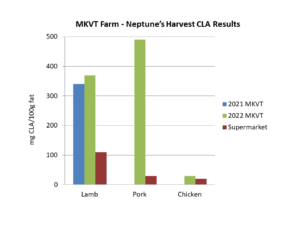
Microbial Soil Test Results
Hayfield transitioned to pasture for lambs supplemented fall 2021 with compost with 4 applications Neptune's Harvest Organic Fish Hydrolysate May 1, June 1, July 15, Sept 1 2022.
| Test Date | Microbes μgC/g soil | Fungal:Bacterial Ratio | % Fungal | % Bacterial |
| May 1 (prior to amendment) | 410.57 | .77 | 43.52 | 56.48 |
| July 1 | 646.09 | 1.25 | 55.56 | 44.44 |
| Oct 1 | 1015.51 | 2.10 | 67.78 | 32.22 |
These results show that an adequate compliment of compost supplemented by 4 applications (3 gallons per acre per application) of Neptune's Harvest Organic Fish Hydrolysate with Kelp provide an ample opportunity to increase the microbial population in the soil. The lambs responded by having a slaughter weight average of 60 lbs, mean of 61 lbs, and distribution of weight from 45 to 76 lbs. Lambs averaged 180 days at slaughter on Oct 27 for an average daily gain of .33 lb per head per day. We grew the largest lamb we have ever had at 76 lbs and had the best average weight ever at 60 lbs which is 5 lbs larger than 2021. The CLA concentration in the 2022 lambs was 370mgCLA/100gFat versus 340mgCLA/100gFat in the 2021 lamb sample.
Lambs with sign July 31 on their 3rd trip through this paddock. June 4, lambs on pasture. Ewes with heads down in a bit of new seeding to supplement their less than ideal pasture.
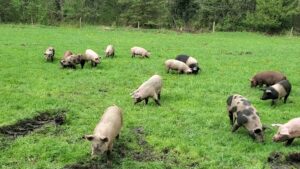
Hayfield transitioned to Pasture for Ewes w/o compost (ground too wet) with 4 applications Neptune's Harvest (3 gal/acre/application)
| Test Date | Microbes μgC/g soil | Fungal:Bacterial Ratio | % Fungal | % Bacterial |
| May 1, 2022 | 123.76 | .11 | 10.25 | 89.75 |
| July 1 | 202.73 | .39 | 27.98 | 72.02 |
| Aug 1 | 303.29 | .57 | 36.5 | 63.5 |
| Oct 1 | 344.41 | .65 | 39.53 | 60.47 |
These results indicate that supplementation with Neptune's Harvest has a positive effect on fungal and bacterial growth but without compost amendment (and wet soil) the increase is much slower. We also started from a more diminished microbial population here vs lamb pasture.
Old Pasture with 4 applications of Neptune's Harvest (3 gal/acre/application)
| Test Date | Microbes μgC/g soil | Fungal:Bacterial Ratio | % Fungal | % Bacterial |
| May 1, 2022 | 163.32 | .16 | 13.49 | 86.51 |
| Aug 1 | 286.75 | .54 | 34.94 | 65.06 |
| Oct 1 | 381.45 | .71 | 41.65 | 58.35 |
These results show a gradual improvement in microbial count with application of Neptune's Harvest but again, without compost the levels remain lower than we would like. Anecdotal reports are that between 3 and 4 years of application of Neptune's Harvest are necessary (without compost) to rebuild the microbial populations and see increased yields.
This link will bring you to a reference chart to better interpret these MicroBiometer results.
These are the test results from the MicroBiometer Cloud. All soil samples were frozen and tested at the same time by the same person to avoid any sampling or testing deviations.
The Chickens
The threat of bird flu this growing season necessitated a change in design in our chicken tractors. We built them 10x16 but with a fixed closed top to reduce the contamination possibility of passing waterfowl. This made the tractors more expensive and heavier but they worked well for the chickens.
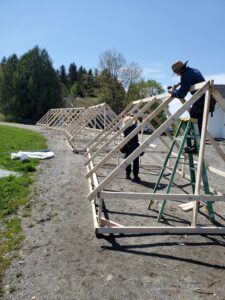


Cold weather added stress to the chickens early and we had significant losses due to ascites (an accumulation of fluid in the peritoneal cavity due often to poor heart condition which can cause right ventricle failure caused by the cold). We had to get our chicks from a new hatchery this year as our old supplier could not provide chicks for our schedule. Genetics can predispose birds to pulmonary hypertension induced ascites. We felt like the genetics of this years chicks were not as strong as from our previous hatchery and despite our efforts to keep them warm, consultation from our advising veterinary and chicken experts we did not have the growth we have enjoyed in previous years, even though our accommodations were better. We finished 703 chickens that ranged in dressed weight of 4 to 8.9 lbs for a total of 4440 lbs of chicken with an average of 6.32 lbs at 7 weeks and 1 day old. The CLA tests showed that the surviving chickens did well on the pasture with limited grain. We will return to our original supplier this year and use the same tractors and management.
Forages

The forages improved in 2022 over 2021 just in quality and quantity of grass. The sheep also ate it better and enjoyed it more. The pasture the lambs grazed did exceedingly well all summer and into October. The October pasture forage sample had a crude protein of 29.4, ADF 21.2, NDF 40.4, Metabolizable Energy of 1.25 (Mcal/lb) and a Relative Feed Value of 167. It was no wonder the lambs grew well and the pigs loved to graze.
The forage analysis of the hay was not impressive with 2nd cut yield off 12 acres of 16,000 lbs of dry hay on July 29 with only a 95 Relative Feed Value. **We did not get a first cut as a custom operator working for our neighbor mistakenly mowed and chopped our 2 fields without our knowing. Third cut on Oct 1 (we were extremely dry in August and the grass didn't grow until September) was a little better with 113 RFV and also 16,000 lbs. But there is something about this hay that the sheep, pigs and even the chickens are attracted to. The hay stays very green and the smell is like fresh hay even after months in storage. I have not found any way to analytically validate this but I have numerous similar anecdotal reports from horse owners, cattle, hay growers in Canada and others about the "freshness" of the hay.
Final Thoughts
We certainly didn't make any extra money with our conversion to supplementation with Organic Fish Hydrolysate, but we feel real good about what we did and what we learned. There is value in this type of system and we can benefit by educating others as to what we have learned, and illustrating to customers the extra value in what we do so we can realize some financial reward as well. The value to us in being able to provide a better sustainable way to nourish our soils, animals, family and customers is worth a great deal to us and we will continue down this path as we build something that perhaps the next generation can grasp, enjoy and benefit as much as we have.
Our results indicate that our speculation, if Neptune's Harvest Organic Fish Hydrolysate can improve soil health and forage quality, that the animals being nourished by these forages would have higher nutritional value in their meats and perhaps an increased health value benefit. We were able to show an improvement in CLA production of both ruminants and monogastric animals which lends credibility that animals grazed on more nutritious forages responded by producing more nutritious meat products. We will continue to test and monitor our soil health, forage quality and nutritional value of the meat products we produce.
We observed an improvement in soil health based on testing carbon levels in the soil tests. This benefit improves the fertility of the land but also improves the carbon sequestration and retention of the soil which was an additional but unexpected benefit. We will continue with the supplementation on our farm and will offer custom application of Neptune's Harvest to other interested farmers. The high price of commercial fertilizer makes this product competitive on a per acre basis and it is less expensive than organic fertilizer. However, there is often a first year decrease in production that has to be factored into the transition. We feel it has significant value and this may eventually become a revenue source for our farm as we aid other farmers in providing a viable, economically significant soil amendment for sustainable agriculture.
We intend to seek out other benefits of Neptune's Harvest at MKVT Farm and around the Northeast. We look forward to sharing these results and those yet to come with everyone that is interested.
Education & outreach activities and participation summary
Participation summary:
We write a regular news letter that goes out to over 200 regular subscribers, https://mailchi.mp/2d50c472e567/neighbors-15796421 , we had an open house, we engaged in conversation regularly about our project with farmers market customers and fellow vendors. We had 3 farmers "try" the Neptune's Harvest supplementation.
Now that our results are all in (except the validation of the pork CLA test) we will begin publishing, doing interviews and looking for speaking opportunities. We have had a number of conversations already with on farm customers, neighbors, farmers and other interested folks, while giving tours of the farm, or while at the Craftsbury Farmer's Market with our SARE sign advertising our grant.
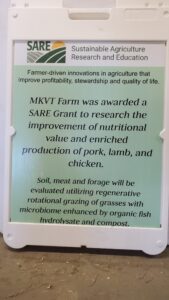
We hope to do some outreach through Neptune's Harvest and have our results published in their product market material. We will approach NOFA to see if we can share with their network. We will send results to the mailing list of Vermont Sheep and Goat Association. We have been in contact with Sterling College about a class presentation after their farm visit.
Learning Outcomes
It was just us at this point that would admit we learned something but we are sure others are going to be ready to learn when they see our results. We learned that we are doing our animals and our customers a great service and although we knew we do a good job, we treat our animals with compassion and respect, we were not aware that our new venture into sustainable agriculture would have benefits to all. We had not contemplated the benefit of healthy soil being able to sequester larger amounts of carbon. We really had no idea that monogastric animals could realize elevated levels of CLA with excellent grazing.
Our attitude and knowledge gained from this project has us already planning the next one with our garden, and new orchard, berry patches and other parts of our farm. We have a lot more to learn and a lot to share.
Project Outcomes
This project provides a foundation for our belief that if we manage our land sustainably and resourcefully we can improve the land, its products and the end user of the products produced. The analytical results will reinforce the benefits to other farmers or organizations that are considering utilization of more organic, sustainable or regenerative methods to improve their land, crops and quality of life.
We contacted 4 doctors of various fields of animal nutrition, animal husbandry, analytical testing and project development who were all intrigued with the goal of the project. We have been able to illustrate our results to them that may also lead to additional field studies, trials and application of our findings for all levels of farms in any location.
We feel strongly enough about the positive benefits of this study to continue supplementing all of our land with Neptune's Harvest and we took advantage of early order discount on 10 drums of product for 2023. We have purchased a larger tractor and larger sprayer with 1000 gallon tank and 60 foot boom to be available to apply fish hydrolysate for interested farmers. We will continue to use the Microbiometer to monitor soil health and we will run annual CLA tests on our lamb, pork and chicken.
The improvement in soil, forage and animal values has lead us to apply for a 30 month grant evaluating growth and health benefits to fruit trees, berry bushes and vines as well as garden vegetables. We will also monitor whether the Neptune's Harvest has any effect on disease and pest resistance.
The success of the project was due to the positive benefits of this product in past personal use. We had a good idea we would see improvements based on anecdotal evidence we had and had heard. We will now have quantification of information to supplement the many anecdotal attributes of Neptune's Harvest. We will continue to use it, find new uses for it, promote it to others, and assist them in purchasing and applying Neptune's Harvest.
We did learn that we were spread pretty thin at times, trying to perform all the extra sampling and data recording in addition to running the farm and participating in a farmers market every Saturday for 20 weeks. We were unable to address the financial and nutritional differences of Neptune's Harvest versus commercial fertilizer since our neighbor's harvesting contractor chopped our first cutting by mistake without us knowing until after the fact. The weather played a critical role as it always does in farming and it wasn't beneficial to our project. We are sure, better weather and less extremes would have resulted in better results, especially chicken completion and final weights.
We will continue to work on this and hope to enlist the support of Neptune's Harvest for some of the necessary testing to strengthen the analytic reliability of our results. The application of this product is essential for reclaiming abandoned or abused land which will be a benefit to many starting farmers in the Northeast. Since this product is also organic, we anticipate that significant cost effective benefits can be experienced by organic farms large and small whether plant or animal based. The carbon sequestration improvements we saw may have an immediate financial impact as agriculture finds itself in a position to profit from carbon credits.
